Posted by: Northwest Eye in General on October 6, 2025
Overview
Color prescription contacts are not just about enhancing your appearance; they also play a vital role in correcting your vision. It’s important to have a valid prescription to ensure that the lenses fit properly and are safe for your eyes. We understand that navigating this process can feel overwhelming, which is why consulting with eye care professionals is crucial. This step helps prevent potential complications such as infections and corneal abrasions.
Additionally, eye care professionals can provide personalized advice on the types of lenses available and how to care for them. It’s common to have questions and concerns, and seeking guidance will help you feel more confident in your choices. Remember, we are here to help you through this process, ensuring that your experience is both safe and satisfying.
Introduction
Color prescription contacts are more than just a fashion statement; they represent a significant intersection of aesthetics and eye health. We understand that as millions of Americans explore the vibrant world of colored lenses, it’s crucial to grasp the nuances—from types of tints to safety considerations.
What are the essential facts every potential user should know to ensure both style and safety in their choice of color contacts? This article delves into the key aspects of color prescription contacts, providing insights that empower you to make informed decisions while enhancing your unique look.
Northwest Eye: Expert Guidance on Color Prescription Contacts
At Northwest Eye, we understand that choosing the right lenses is an important decision for you. Our team of experienced ophthalmologists is dedicated to offering thorough advice on color prescription contacts, ensuring you feel confident in your choices. With over 50 years of expertise in eye care, we prioritize personalized attention and tailored to your unique needs.
We know that many individuals are curious about colored lenses, especially as recent trends show that around 37 million Americans use corrective eyewear, with a growing interest in color prescription contacts. Our commitment to patient education empowers you to make informed choices about your eye health, particularly regarding the use of color prescription contacts.
It’s common to feel overwhelmed when selecting the right lenses, but our eye care professionals emphasize the importance of guidance throughout this process. Proper lens care and regular check-ups are essential for maintaining your eye health, and we are here to help you navigate these choices. Many individuals have documented successful results, experiencing better color differentiation and enhanced daily activities through tinted lenses.
As we look ahead to 2025, the market for color prescription contacts continues to evolve, reflecting advancements in technology and your preferences. We are committed to supporting you every step of the way, ensuring that your eye care journey is as smooth and reassuring as possible.
Types of Color Prescription Contacts: Visibility, Enhancement, and Opaque Tints
There are three main types of : visibility tints, enhancement tints, and opaque tints. We understand that choosing the right type can feel overwhelming, so let’s break it down together.
- Visibility tints are subtle shades designed to help you manage the optics, ensuring you can see them easily during insertion and removal.
- Enhancement tints, however, are semi-transparent and work to amplify your natural eye color, giving you a more vibrant appearance without completely changing your original shade.
- On the other hand, opaque tints offer a dramatic transformation by fully changing your eye color, making them a great choice for those with darker irises who are seeking a striking new look.
Comprehending these differences is essential for selecting the optics that align with your aesthetic desires.
For beginners, optometrists often recommend visibility tints, as they provide a gentle introduction to color contacts. If you’re looking for a more pronounced change, enhancement and opaque tints might be the way to go. Many patients have shared their satisfaction with enhancement tints, noting how they can subtly elevate one’s natural beauty. In contrast, opaque tints are celebrated for their bold impact, allowing wearers to express their unique style.
According to market insights, the colored lens market is projected to grow significantly, reaching USD 8,969.29 million by 2032. Opaque tints are expected to hold the largest share due to their popularity among fashion-conscious users. As industry expert Rajdeep Kumar Deb points out, the rising demand for cosmetic eye transformations is expanding the market beyond just medical use.
If you’re contemplating color prescription contacts, we are here to help you through this process. It’s recommended to consult with an optometrist to identify the best choice based on your personal requirements and preferences. Remember, you are not alone in this journey, and we are committed to supporting you every step of the way.
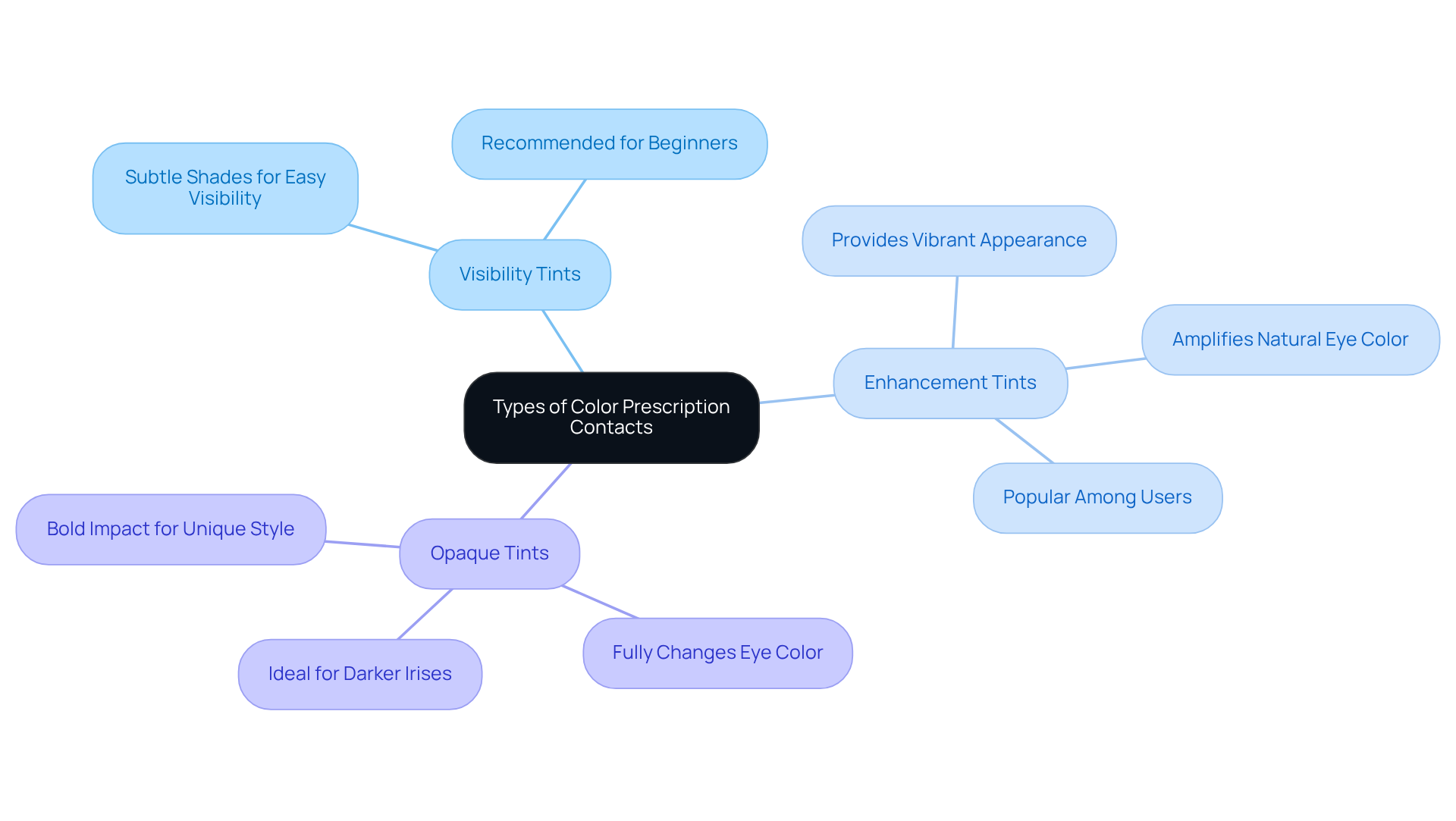
Safety Considerations: Are Color Prescription Contacts Safe for Your Eyes?
Color prescription lenses can be safe when used properly, and it’s important to acquire them from a licensed eye care expert to ensure they are FDA-approved. We understand that navigating this can be overwhelming, but the , including tinted ones, as medical instruments. This highlights the significance of appropriate fitting and oversight. Since 2005, it has been unlawful to sell vision correction items without a prescription in the U.S., which underscores the legal structure regarding such sales.
It’s common to feel concerned about the safety of color prescription contacts. Statistics show that approximately 60% of colored contacts bought online without a prescription harbor bacteria, based on the FDA’s examination of 300 unlawfully sold products. This emphasizes the dangers of unregulated sources. To protect your eyes, proper hygiene practices are essential. Washing your hands before handling contacts and adhering to the recommended wear schedule can significantly reduce the risk of eye infections and complications.
Ophthalmologists highlight that consulting with your vision care provider is crucial for getting color prescription contacts. This ensures that your prescriptions are appropriate for your sight and provides you with valuable advice on safe use. As the FDA cautions, “Your eyes are at risk of severe damage — and possibly blindness — when you wear corrective lenses that were not prescribed specifically for you.” Following these precautions can help prevent serious issues, including corneal abrasions and infections, which may lead to permanent vision loss.
We want to emphasize that the consequences of improper use can be severe. For instance, two patients needed corneal transplantation because of complications from cosmetic eye coverings. We are here to help you through this process, ensuring that you have the information and support you need to make safe choices for your eye health.

Care Tips: How to Properly Maintain Your Color Prescription Contacts
To ensure the longevity and safety of your color prescription contacts, we understand how important it is to follow these essential care tips:
- Daily Cleaning: It’s crucial to clean your eyewear every day using a suggested solution. This simple step can help eliminate debris and avoid buildup, giving you peace of mind.
- Proper Storage: Keeping your optics in a clean case filled with fresh solution is vital for maintaining sterility and preventing contamination. We know that only 26% of contact users every three months, highlighting an area where many can improve their care practices.
- Avoid Water Exposure: We want to remind you to refrain from using your contacts while swimming or sleeping. Moisture can lead to complications, such as infections. As Tomislav Kuzman, MD, PhD, wisely noted, “Using tap water for cleaning optics can significantly elevate the risk of contamination and related complications.”
- Prompt Substitution: It’s essential to adhere to your eye care specialist‘s advice on when to change your corrective devices. This practice can prevent discomfort and ensure optimal vision, which we know is important to you.
- Monitor for Issues: Regularly checking for signs of irritation or discomfort is key. If you experience any problems, please consult your eye doctor promptly. Your well-being is our priority.
Eye care specialists emphasize that appropriate upkeep is essential for avoiding issues related to color prescription contacts. As one expert noted, “Patients often underestimate the importance of regular cleaning and case replacement, which can lead to serious eye health issues.” Additionally, the average self-evaluating compliance grade among patients is 3.76, indicating a discrepancy between perceived and actual compliance. By adhering to these suggestions, you can improve your experience with tinted lenses and preserve your eye health. Remember, we are here to help you through this process.
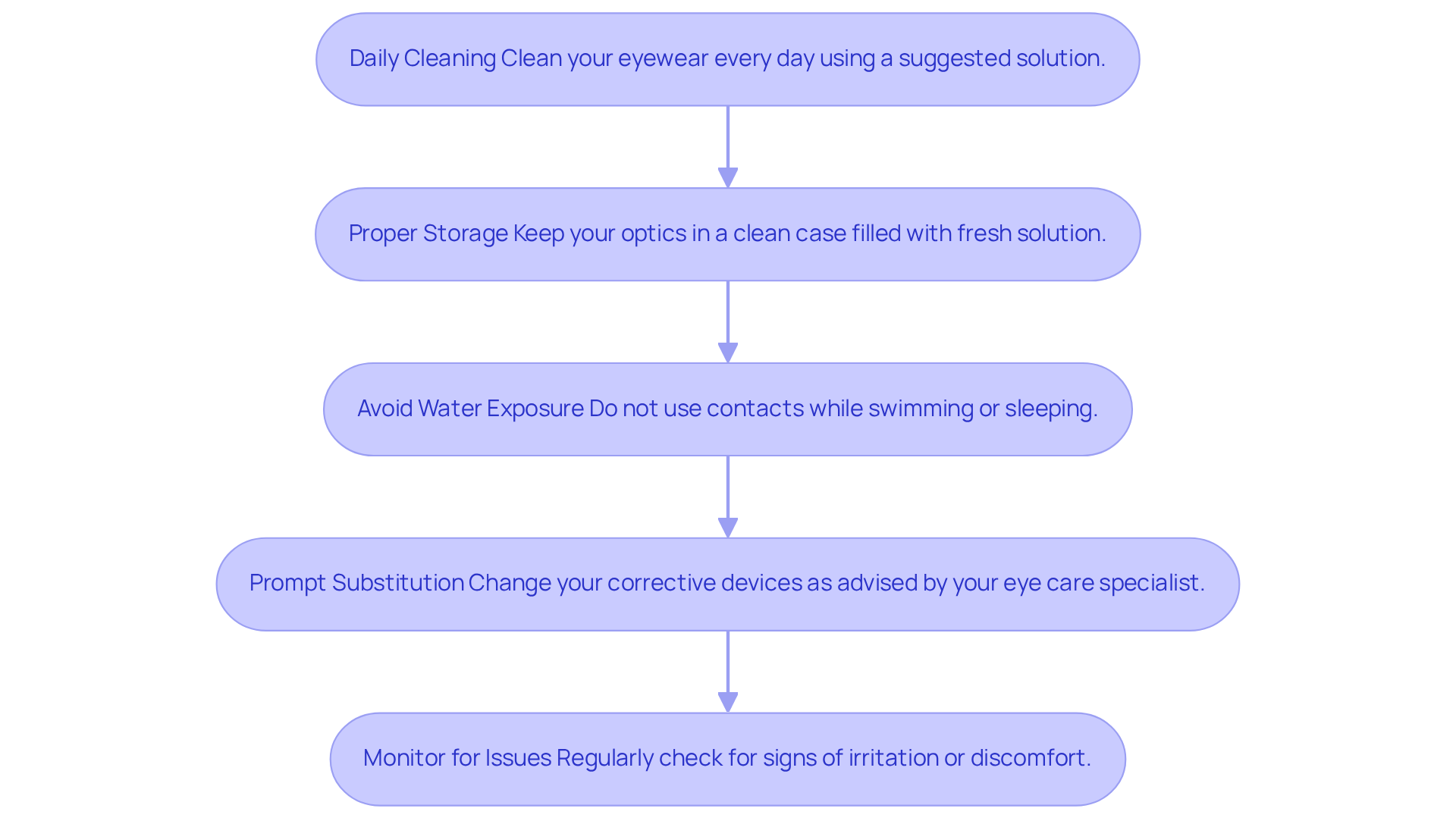
Prescription Requirements: Do You Really Need a Prescription for Color Contacts?
Yes, we understand that you may have questions about tinted eyewear. Even if you don’t require vision correction, a prescription for color prescription contacts is necessary. This requirement ensures that the optical devices fit your eyes properly, significantly reducing the risk of complications such as infections, corneal abrasions, and other serious eye health concerns. It’s common to feel concerned about safety, especially when data shows that individuals who wear non-prescription tinted lenses are 16 times more likely to develop keratitis, a painful eye infection.
Furthermore, we want to highlight that over 70% of colored contact lens (CCL) users reported first use at under 15 years old, indicating a trend of early usage among adolescents. We’ve heard numerous stories from users; for instance, one teenager unfortunately , while another experienced intense discomfort and sight impairment after just 10 hours of use. In fact, about 60% of non-prescription users of corrective eyewear reported eye issues such as pain, itchiness, redness, and swelling.
Eye care specialists emphasize that purchasing color prescription contacts without a prescription can lead to irreversible harm, including lasting vision loss. Dr. Thomas Steinemann cautions, ‘Wearing decorative eye inserts can be hazardous.’ It’s also important to note that since 2005, it has been illegal in the U.S. to sell lenses without a prescription. We encourage you to always consult with a licensed eye care expert to ensure your safety and proper fitting before using tinted lenses. We are here to help you through this process, ensuring your eye health is protected.
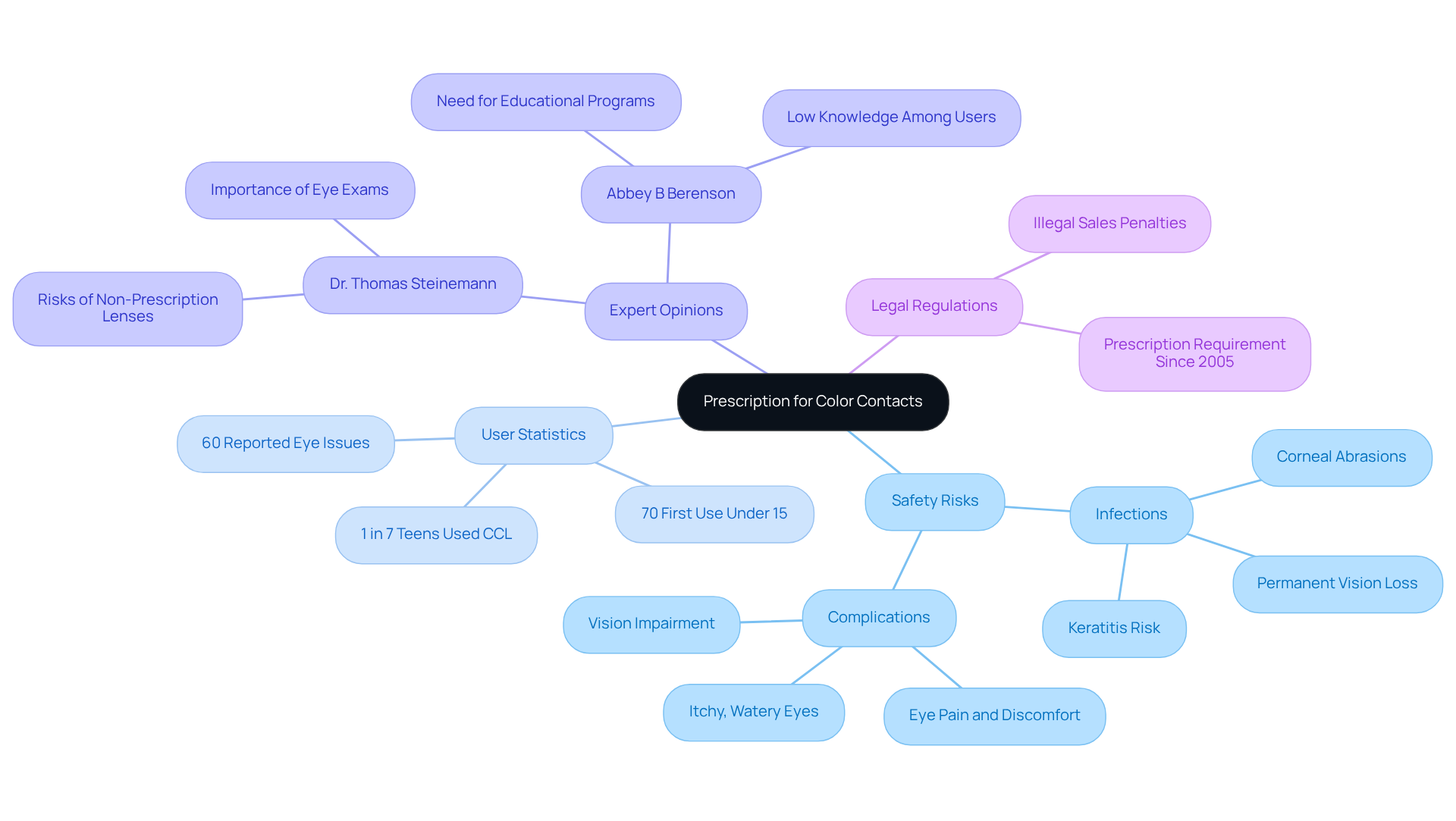
Potential Risks: Understanding the Dangers of Color Prescription Contacts
Wearing tinted prescription lenses can pose serious risks, including , corneal abrasions, and allergic reactions. We understand that ill-fitting eyewear can lead to discomfort and significant issues, and non-prescription colored vision aids can worsen these risks. For instance, there have been many documented cases where individuals experienced severe eye infections or even lasting vision impairment after using decorative contacts without proper fitting or medical supervision. One notable case involved Julian, a teenager who tragically lost vision in one eye due to costume lenses obtained without a prescription. This highlights the potential for severe consequences.
Research indicates that using non-prescription eyewear can increase the risk of infections, such as keratitis, by as much as 16 times. Ophthalmologists emphasize the importance of obtaining a legitimate prescription, as all contact optical products are classified as medical devices by the FDA. This classification underscores the necessity of professional fitting and care instructions to prevent complications.
Additionally, the materials found in many over-the-counter tinted contacts can be harmful, leading to corneal abrasions and ulcers. These injuries may require surgical intervention, such as a corneal transplant, to restore vision. Experts caution that the risks associated with cosmetic lenses should not overshadow the critical need for safety and proper eye care. If you notice any discomfort or changes in vision while using tinted lenses, it is essential to consult your eye care provider promptly to protect your eye health. Remember, we are here to help you through this process.

Fitting Process: How to Get the Right Fit for Your Color Prescription Contacts
The fitting procedure for color prescription contacts begins with a comprehensive eye examination performed by an eye care specialist. We understand that this process can feel overwhelming, but rest assured, this examination includes to determine the suitable size and curvature. It also evaluates your overall eye health to ensure that tinted options are appropriate for you.
Proper fitting is essential; it not only enhances comfort but also significantly reduces the risk of complications such as irritation or infection. Research shows that individuals who undergo a thorough fitting procedure report greater satisfaction levels. Many express joy in both the visual and practical aspects of their tinted lenses.
As Sam Winnegrad, a master optician, highlights, ‘Expertise in the use of the slit lamp is essential for the lens fitter.’ Omitting this vital stage can lead to discomfort and potential eye health issues, making it crucial to prioritize a professional fitting for your color prescription contacts.
Additionally, regular eye exams are vital for maintaining eye health and ensuring that your prescription remains accurate. We are here to help you through this process, ensuring that you feel confident and supported every step of the way.

Consultation Importance: Why You Should See an Eye Care Professional for Color Contacts
Consulting with an eye care professional before using color prescription contacts is essential for several reasons. We understand that ensuring your is crucial for your comfort and eye well-being. A comprehensive eye assessment guarantees this fit, significantly minimizing the risk of complications such as corneal abrasions and infections that can arise from improper use of contact devices. Studies show that patients who receive professional fittings report higher satisfaction and experience fewer discomfort symptoms compared to those who self-fit their lenses.
Moreover, eye care professionals are here to educate you on safe usage practices for color prescription contacts, including the importance of regular cleaning and proper hygiene. They can also assist you in choosing the right kind of color prescription contacts that not only enhance your eye color but also align with your aesthetic tastes. For instance, patients who consulted with specialists often experience improved comfort and visual clarity, as these professionals tailor recommendations based on your individual eye health needs.
Ophthalmologists stress that professional advice is essential, especially for individuals with certain conditions such as astigmatism, where toric lenses may be required. It’s common to feel uncertain about which options are best for you, but real-world examples demonstrate that those who heed professional guidance not only experience improved self-assurance through their selection of tinted eyewear but also maintain better overall eye health. This thorough approach highlights the significance of consulting an eye care expert to ensure a safe and fulfilling experience with tinted lenses.
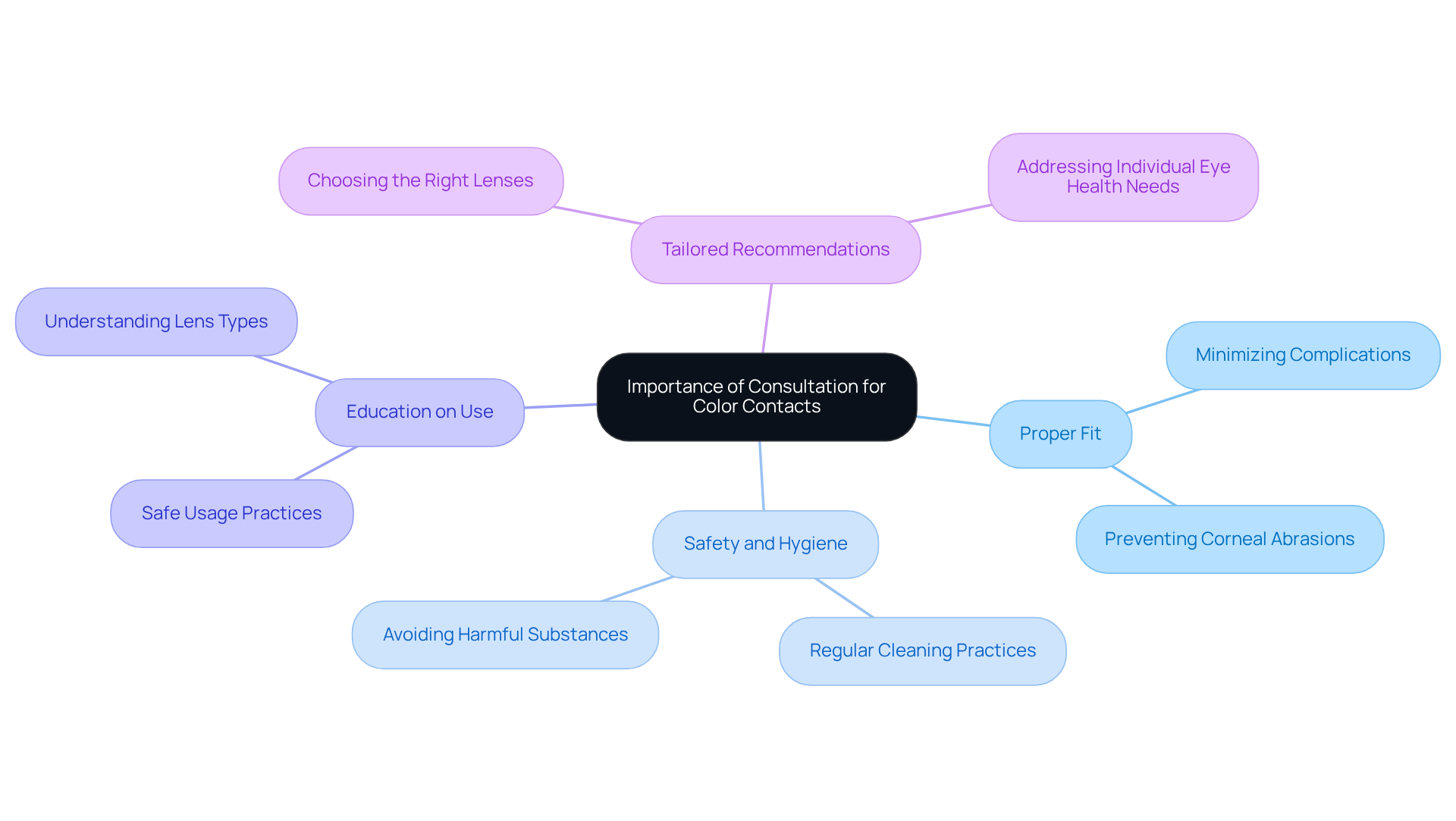
Cosmetic Benefits: Enhancing Your Look with Color Prescription Contacts
Color prescription contacts offer a wonderful way to enhance your appearance and express your unique style. We understand that you may want to subtly or make a bold statement with vibrant shades through color prescription contacts. Tinted lenses can significantly transform how you look, and they come in a wide variety of colors and designs. This variety of color prescription contacts allows you to explore different looks that suit various occasions, from everyday wear to formal events.
Looking ahead to 2025, we anticipate a growing demand for color prescription contacts, driven by an increasing awareness of their aesthetic benefits. Research from the American Academy of Ophthalmology reveals that over 70% of young adults consider eye color a vital aspect of their personal style. This highlights the importance of tinted eyewear in today’s fashion landscape. Fashion experts emphasize that color prescription contacts not only enhance your appearance but also act as a versatile accessory that can elevate any outfit.
Consumer preferences show a strong inclination toward natural and subtle colors, with many individuals seeking optics that blend seamlessly with their features. It’s common to feel inspired by the growing presence of tinted eyewear showcased by influencers and celebrities on social media. As the market continues to evolve, innovative materials and designs are enhancing both comfort and safety, making tinted lenses a favored choice for aesthetic enhancement and vision correction. Furthermore, the global market for colored eye products is projected to reach USD 7.19 billion by 2030, reflecting the rising interest among consumers in these appealing options.
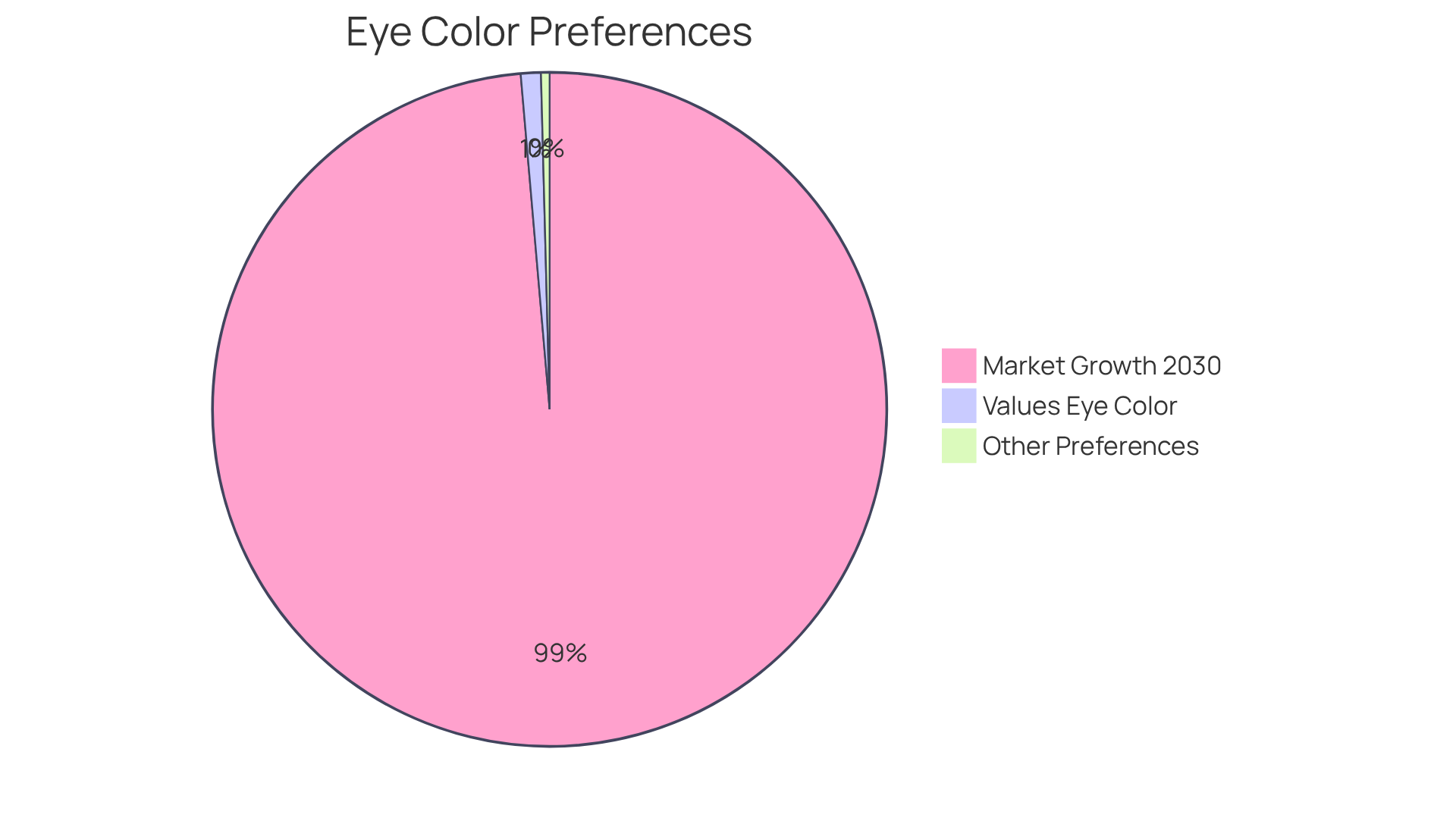
Key Takeaways: Essential Facts About Color Prescription Contacts
In summary, we understand that you may have questions regarding color prescription contacts. Here are some essential facts to consider:
- Always acquire a prescription from a certified eye care expert. This ensures that your eyewear .
- Familiarize yourself with the different types of tints available: visibility tints help in locating glasses, enhancement tints amplify your natural eye color, and opaque tints completely change eye color.
- It’s important to follow proper care and maintenance practices. Regular cleaning and disinfecting are crucial to maintaining your eye health and preventing infections.
- Be aware of the potential risks associated with improper use. Issues like corneal abrasions and infections can lead to serious complications. For instance, research indicates that there are 2 to 5 cases of microbial keratitis per 10,000 lens users, highlighting the importance of appropriate lens maintenance.
- Consult with your eye care provider for a proper fitting and personalized advice tailored to your specific needs.
By adhering to these guidelines, you can safely enjoy the aesthetic benefits while prioritizing your eye health with color prescription contacts. Remember, as the U.S. Food & Drug Administration states, “Always seek professional advice, obtain a valid prescription, purchase from reputable sources, and adhere to strict hygiene practices.” We are here to help you through this process.
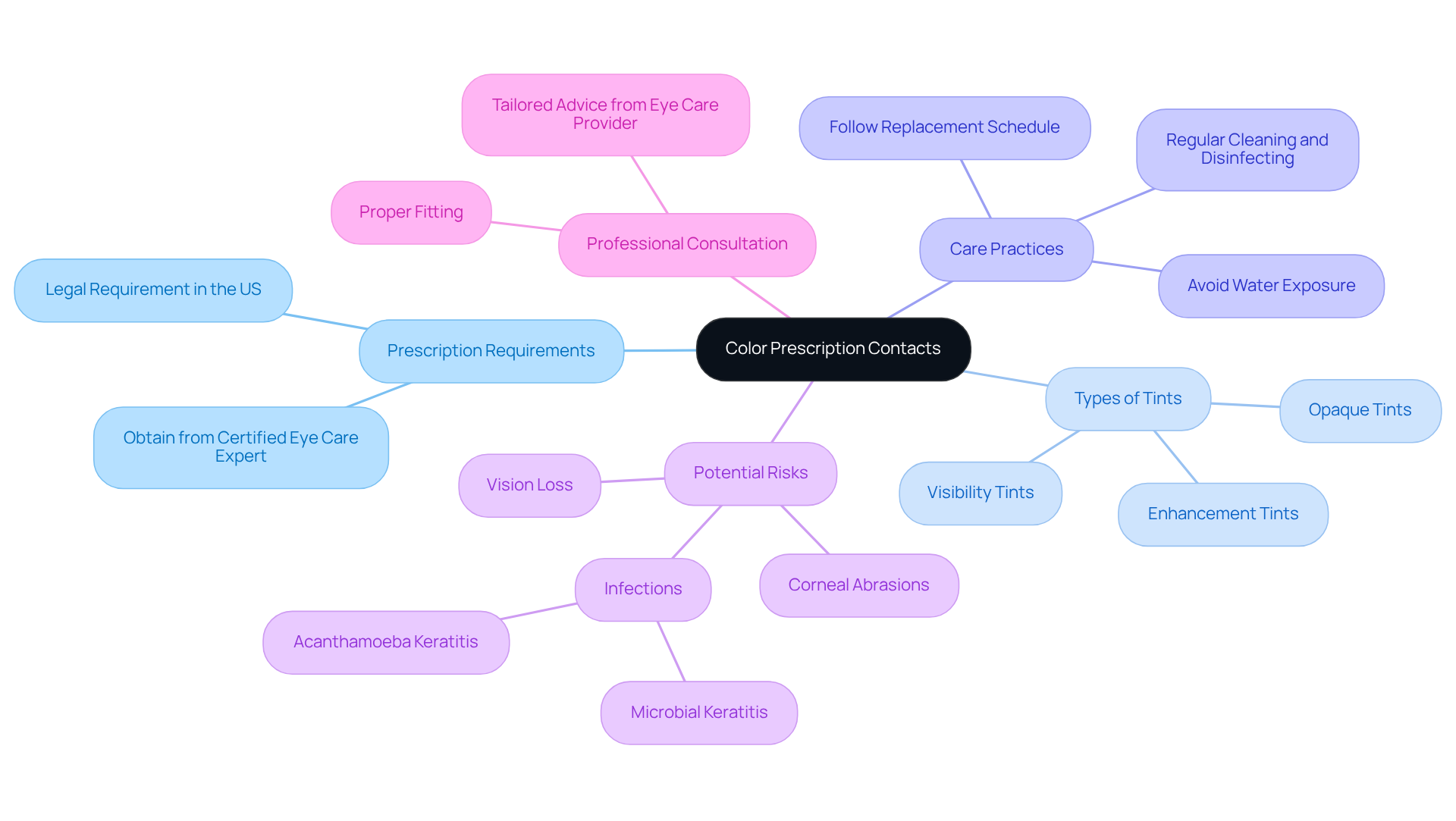
Conclusion
Color prescription contacts offer a wonderful opportunity to enhance your personal style while also addressing your vision needs. We understand that choosing the right lenses can feel overwhelming, which is why it’s essential to grasp the key facts surrounding these lenses. By consulting with eye care professionals and following safety guidelines, you can enjoy the beauty of color contacts without compromising your vision or well-being.
This article highlights important aspects of color prescription contacts, such as:
- The necessity of obtaining a prescription
- The various types of tints available
- The importance of proper care and maintenance
It’s common to feel concerned about potential risks like infections or discomfort from improper use, so being aware of these factors is vital for ensuring a positive experience with your lenses. Moreover, the fitting process and the significance of professional guidance are crucial, as they greatly enhance your comfort and safety.
As the market for color prescription contacts continues to grow, we must prioritize eye health alongside the cosmetic benefits. Taking proactive steps by consulting eye care experts, following hygiene practices, and choosing reputable sources for your lenses can make all the difference. By doing so, you can confidently embrace the vibrant world of color prescription contacts while safeguarding your vision for years to come. Remember, we are here to help you through this process, ensuring that you feel supported every step of the way.
Frequently Asked Questions
What are color prescription contacts?
Color prescription contacts are specialized lenses that not only correct vision but also alter the color of the wearer’s eyes. They come in various tints and styles to cater to different aesthetic preferences.
What types of color prescription contacts are available?
There are three main types of color prescription contacts: visibility tints, enhancement tints, and opaque tints. Visibility tints are subtle shades for easier handling, enhancement tints amplify natural eye color, and opaque tints completely change eye color for a dramatic effect.
How can I choose the right type of color prescription contact?
Beginners are often recommended to start with visibility tints for easier handling. If you want a more noticeable change, enhancement tints can subtly elevate your natural beauty, while opaque tints are ideal for a bold transformation.
Are color prescription contacts safe to use?
Yes, color prescription contacts can be safe when used properly and obtained from a licensed eye care expert. It is crucial to ensure they are FDA-approved and to follow proper hygiene practices to minimize the risk of eye infections.
What are the risks of using color prescription contacts purchased online?
Approximately 60% of colored contacts bought online without a prescription contain bacteria, which can pose significant risks to eye health. It is important to acquire lenses from regulated sources to avoid complications.
What precautions should I take when using color prescription contacts?
Always wash your hands before handling contacts, adhere to the recommended wear schedule, and consult with your vision care provider to ensure you have the correct prescription and safe usage guidelines.
What should I do if I experience problems with my color prescription contacts?
If you experience any issues, such as discomfort or vision changes, contact your eye care provider immediately for advice and potential treatment to prevent serious complications.
How is the market for color prescription contacts expected to grow?
The colored lens market is projected to grow significantly, reaching USD 8,969.29 million by 2032, with opaque tints expected to hold the largest share due to their popularity among users seeking cosmetic transformations.






